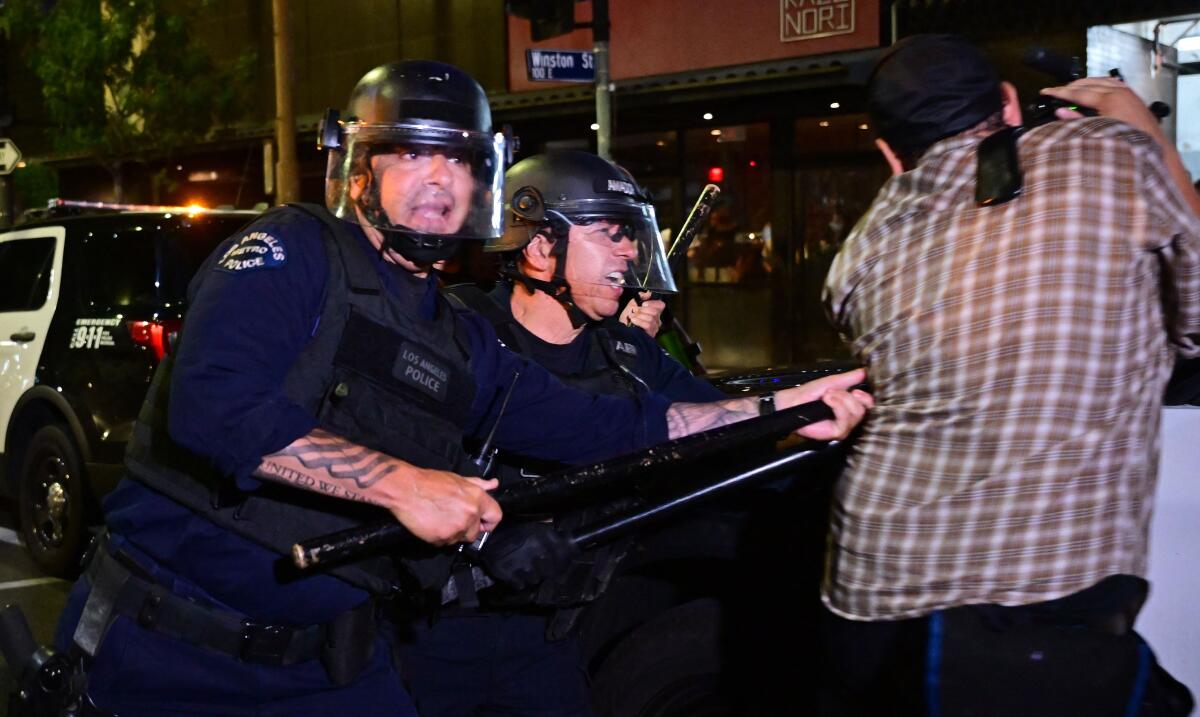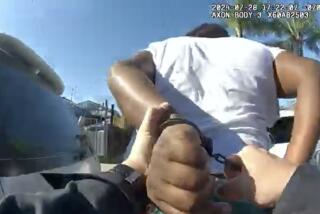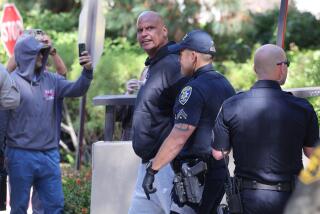LAPD treatment of journalists denounced, again, after abortion rights protest downtown

- Share via
Independent journalist Tina-Desiree Berg was standing on a sidewalk filming the arrest of an abortion rights protester in downtown Los Angeles on Friday night when a police officer hit her on the side of the head.
Berg, a regular chronicler of L.A. protests, had been “focused on getting the shot” of the arrest and hadn’t even seen the officer approaching her, she said. As she tried to find her bearings, another officer shoved her so hard she fell to the ground, video showed.
Others in the area shouted that Berg was a journalist as she got back to her feet and showed her press credentials — hanging around her neck — to the officer who shoved her.
“We’re trying to protect you,” he said — which made Berg and others bristle.
“It was so poorly handled, I still can’t believe it,” Berg told The Times on Saturday morning.
Journalists and press observers said the incident fit a broader pattern of aggressive and seemingly unlawful treatment of journalists by LAPD officers during the protests, which followed the U.S. Supreme Court’s ruling overturning the 1973 Roe vs. Wade decision.
Over the course of several hours, LAPD officers repeatedly ignored recently expanded protections established for journalists covering protests in the state and used physical force to remove them from areas where they had a right to be, journalists said.
According to Times reporters, witnesses’ videos and interviews with other media members on the ground, journalists were pushed, struck with batons, forced out of areas where they had a right to observe police activity and blocked from entering other areas where police and protesters were clashing and arrests were being made.
LAPD Chief Michel Moore said the department will be investigating the complaints.
“We’ll investigate every allegation of misconduct, which includes that a member of the media demanded and should have been afforded access and were denied,” Moore said. “If the officer is found to have ignored the law, ignored the policy, then disciplinary action will follow.”
The latest incidents follow years of discussions among Moore, other top LAPD leaders and media representatives about mistreatment of the press by officers — including at mass protests after George Floyd’s murder in 2020 and at demonstrations over the clearance of a homeless encampment in Echo Park last year.
Gov. Gavin Newsom signed a law in part in response to those incidents that expanded the rights of journalists covering protests, and the LAPD introduced a new policy making it clear that journalists — from major media organizations and independent outlets as well — have a right to cover protests and enter areas that police have blocked off.
Adam Rose, chair of the L.A. Press Club’s press rights committee and a leader in the push to get the legislation passed, said much of those protections seemed to have been forgotten Friday night.
“After all of the legwork that’s been done to try and prevent this with LAPD over the last couple of years, it’s heartbreaking to see this repeat in the field over and over,” Rose said.
Rose spent part of Friday night collecting examples of LAPD officers violating journalists’ rights, including in videos that the journalists posted to Twitter.
Rose said the actions of the officers captured in the videos were “extremely inappropriate and a pretty clear violation of the new law.”
In the wake of the Supreme Court’s Roe vs. Wade decision, protesters took to the streets across L.A. and around the country. Many in L.A. went downtown, where some managed to march along the 110 Freeway while others gathered around City Hall and Pershing Square.
About 7:45 p.m., officers had cleared the freeway and were moving across an overpass when independent photojournalist Joey Scott and L.A. Taco reporter Lexis-Olivier Ray began filming them from the sidewalk.
The LAPD’s policy states that members of the media, independent or otherwise, “may enter” areas where police are clearing out protesters and shall not be cited for failing to disperse. It also says officers “shall not intentionally assault, interfere with, or obstruct the duly authorized member of the media who is gathering, receiving, or processing information for communication to the public.”
Scott and Ray repeatedly identified themselves as press to the advancing officers on the overpass, but the officers did not seem to care and started shoving the journalists and shouting at them to “Leave the area.”
Then, as Scott stepped onto a crosswalk, an officer “took his baton into my chest and shoved me to the ground,” Scott said.
“Their demeanor was just very sarcastic and just not really communicative,” Ray said. “There were no protesters there, there was no threat, and I was kind of surprised that they responded like that.”
Ray said the incident “set the tone” for the rest of the night, when officers, with a few positive exceptions, continued ignoring the rights of journalists. He said they ignored his questions about where the department had designated media staging areas and his requests to speak to supervisors — both of which are violations of the policy.
Times journalists also were denied access at points, pushed out of areas where they had a right to be under state law and the Constitution, and had requests to speak to supervisors denied.
Sam Braslow, a reporter with the Beverly Hills Courier, was filmed being shoved backward by one group of officers through another line of officers.
“I haven’t seen officers this aggressive in a long time. Police violently handled other members of the press as well,” Braslow wrote on Twitter shortly after 9 p.m.
“It was a huge, huge step backwards,” Ray said, of the LAPD response to journalists Friday night.
“Last night was some of the most egregious acts of violence I’ve seen against protesters and press in a while,” Scott said.
Capt. Kelly Muniz, the LAPD’s chief spokeswoman, said the department was aware of complaints from journalists on Friday night, and took steps to address them immediately.
About 10:17 p.m., Muniz sent a message to all officers about respecting the rights of media.
“If you encounter members of the media, be reminded that a supervisor shall be contacted immediately and the access they are afforded should be assessed based on the behavior of the individual, opposed to having formal credentials,” the emailed message said.
“Facilitating the right to free press is critical to the other freedoms we enjoy,” Muniz wrote.
Moore said that while most officers would not have received that message while deployed in the street, commanders were also assessing conditions on the ground and trying to facilitate journalists’ access where possible.
He said officers had a lot on their plates, such as encountering one protester who was using an aerosol can “as a flamethrower,” getting rocks and bottles and firecrackers thrown at them, and trying to deal with an “incursion” onto the freeway that presented a physical threat to protesters, journalists, officers and motorists alike.
In such scenarios, the physical safety of officers and others — including journalists — has to be a priority, Moore said. But, he said, he also expects officers “to try to do their best to respect that access to the media is given.”
“I want our people and the media to have a harmonious relationship. I want us to be able to work together,” Moore said. “As a journalist, I want you to feel like the department is respecting your rights and access, and that we’re doing our best.”
On Friday night, that was simply not many journalists’ perception.
Berg, who had “bruises everywhere” by Saturday, said the force used against her was extreme and came without any request first from the officer she was trying to film for her to give him more space.
The officer who shoved her “could have just said, ‘Can you move over a foot? I know you’re trying to get a shot,’ and I would have been like, ‘Sure.’”
Berg said that while the physical force was the most jarring, it was indicative of a much bigger problem Friday night — which was the general disregard among officers for the rights of journalists at the scene.
“Every time you tried to show credentials to them,” she said, “they didn’t care.”
More to Read
Sign up for Essential California
The most important California stories and recommendations in your inbox every morning.
You may occasionally receive promotional content from the Los Angeles Times.










